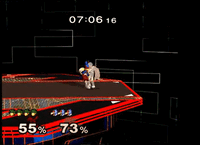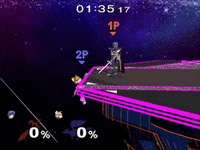Princess / Swordsman spike

The Princess/Swordsman spike is a specific technique in Super Smash Bros. Melee which can only be performed by Peach, Roy, and Marth. It is done by activating the invisible ceiling glitch with their respective counterattacks, causing the player's next attack to knock the opponent at a different trajectory than usual.
How to perform
To setup the invisible ceiling glitch, the L or R are need to be pressed to shield. The shield should be released by letting go of the button or using jump, roll, or grab and counterattack a grounded attack. The opponent must be hit while they are airborne. If done currently, the opponent would be knocked back and at a different angle. If it is activated on stage it will send them slightly away and then straight down. If the attack knocks the opponent off-stage it will remove all vertical velocity, but retain the horizontal knockback and hitstun. This turns attacks that have upwards knockback into powerful spikes.
How it works
The invisible ceiling glitch is notoriously easy to activate with these three attacks specifically. This is likely because Peach's Toad hitbox and Marth and Roy's counter hitbox are very similar to the hitbox of a shield and are color-coded as the same type of hitbox as shields in debug mode. A standard invisible ceiling glitch is triggered by going airborne while still sliding back after a grounded attack hits an opponents shield, which can happen by either getting hit out of their attack on shield or for certain characters by walking or dropping through a platform after hitting an opponents shield with a specific attack. Normally if the player hit a counter it won't cause any of the shield push back required to trigger an invisible ceiling glitch. However, once the player has used their shield earlier on that stock when the player's opponents attacks the player counter, they will receive the same push back as they would have if they attacked the shield the player were previously holding up.
The player's counter will still be able to trigger the Princess/Swordsman spike until the player release a shield when it is incredibly small or the next time the player dies. Also, moving around or using the counter does not undo the glitched shield + counter hybrid. The spike is much easier to perform on the left side of the stage then the right due to how the invisible ceiling glitch works. When activated on the right side, the opponent is ceilinged for only a small window of time, forcing the player to be quick and precise. When activated on the left side, the opponent is ceilinged indefinitely until they are no longer airborne or lose a stock, allowing the player much more time and lenience on how to approach.
Video demonstration
How the shield affects the spike
The size of the player's shield before the player releases it has an impact on how soon after the player's counter will trigger the invisible ceiling glitch and the opponent will lose their vertical knockback. This is because the size of the player's shield is directly related to the amount the opponent is pushed back when they hit the player shield. If the player releases a smaller shield, they will lose their vertical momentum sooner. If the player makes their shield too small, they may not have any backwards momentum when the counter hits, which means it will not trigger the invisible ceiling. If the player is too slow to release a hard shield, the game may register a light shield during the time the player spring pushed the player shoulder button back to its resting position. In this case, the player needs to release the trigger quickly or use an out of shield option to avoid the risk entirely. The stronger the move that hits the player counter is, the longer it takes for the player's counter to trigger the invisible ceiling and the lighter the player can hold their shield while still triggering the glitch.


